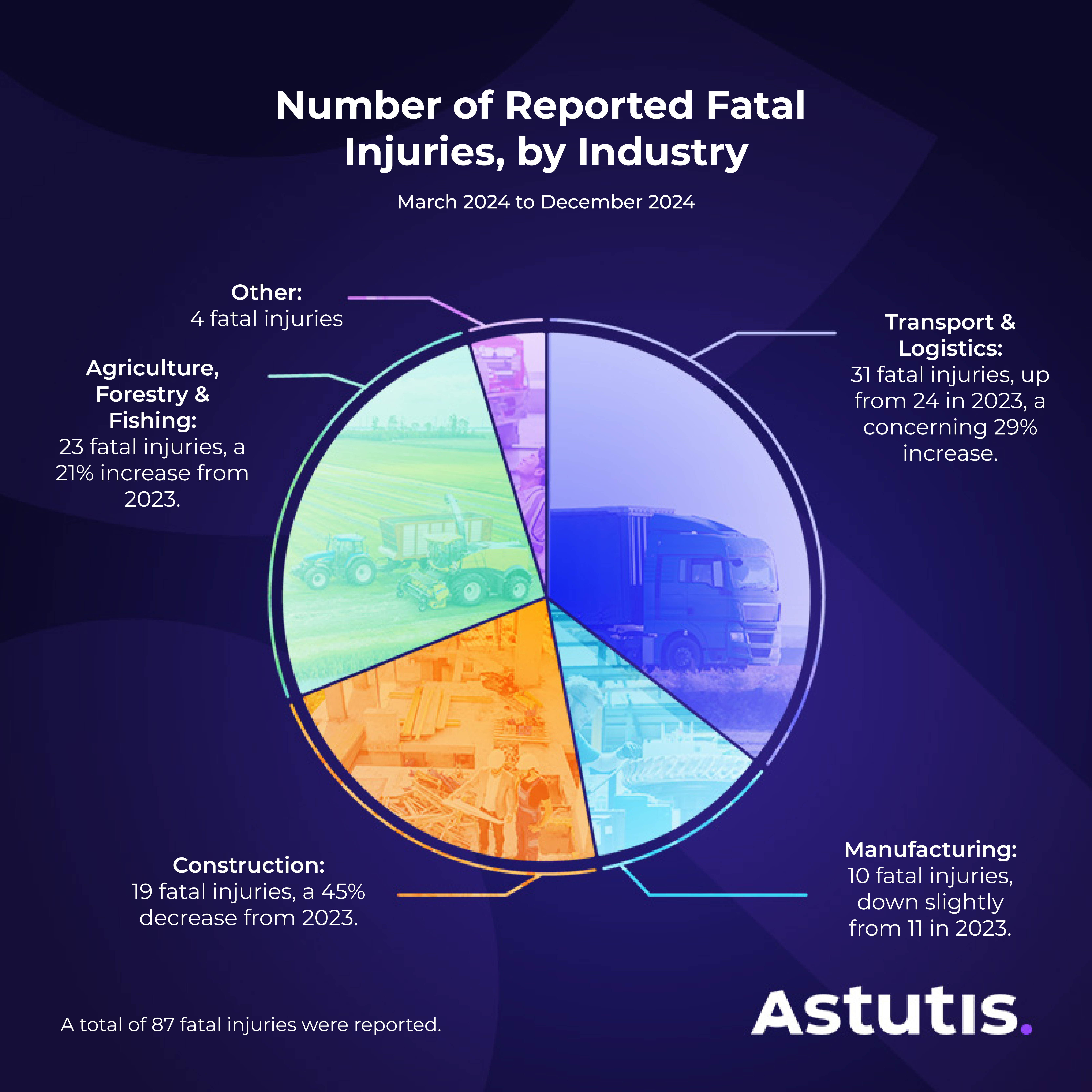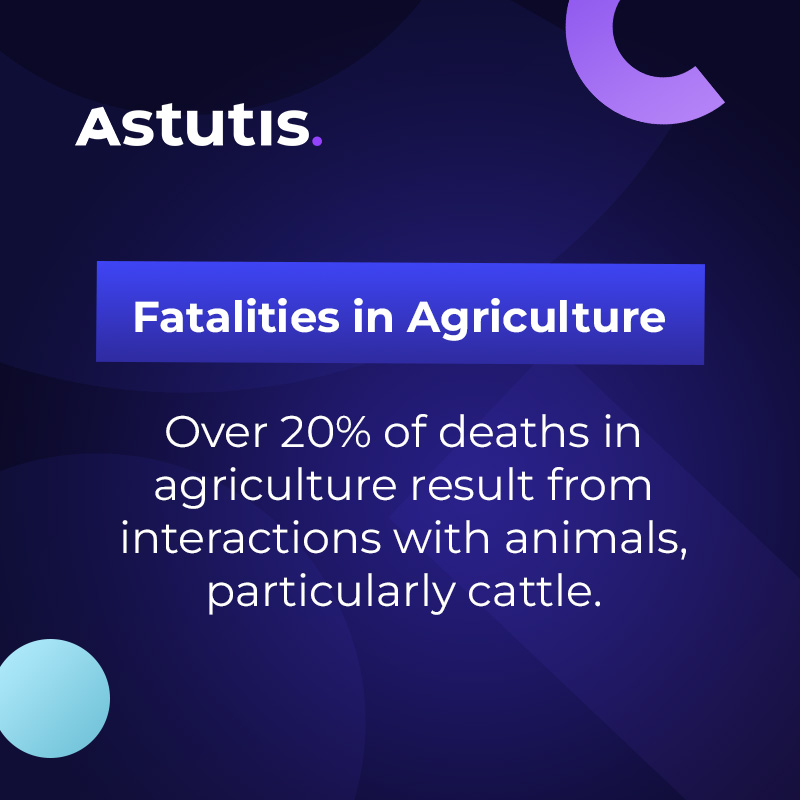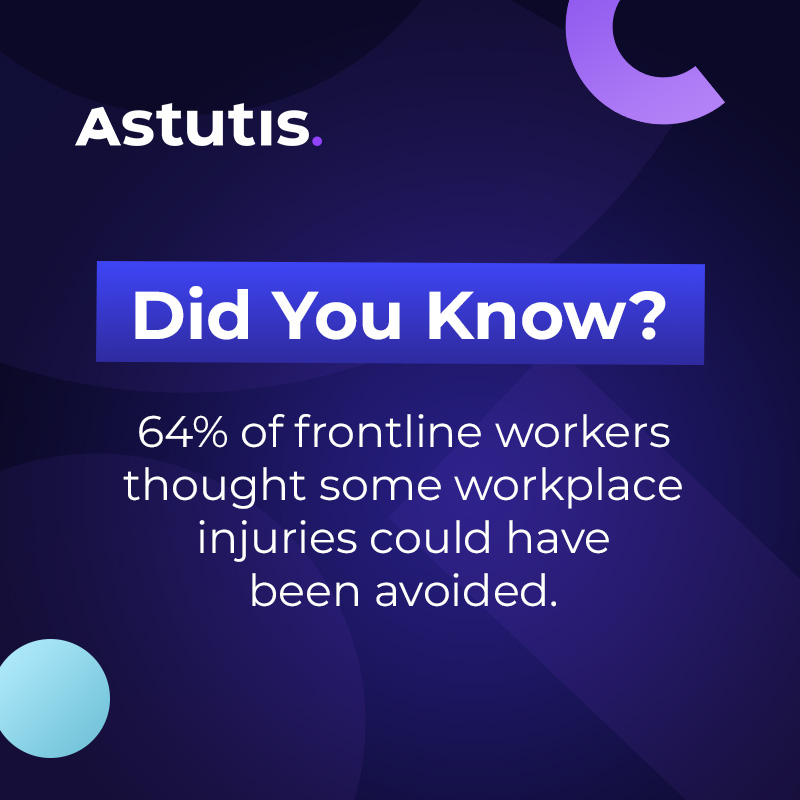5 Takeaways from the UK Fatal Injury Statistics Update | April - December 2024
The Health and Safety Executive (HSE) has released an update on the number of workplace fatal injuries that have occurred between April 2024 to December 2024. As the report has been updated each quarter, we have noticed several signs of significant progress in certain industries, but a regression in others. There has been a very concerning rise in fatal injuries to members of the public and large shifts in the industries responsible.
There are several key takeaways from the statistics, and we've provided insights for how the most dangerous industries might better protect both their employees and members of the public to prevent further tragedies.
Number of Workplace Fatal Injuries Reported in the UK, By Industry
The latest update for the 2024-25 fatal injury statistics, published by the Health and Safety Executive (HSE), has a breakdown of fatal injuries across all industries in the United Kingdom.
The figures show there were 87 total worker fatalities, marking a slight decrease from 92 during the same period in 2023-24. Whilst it is positive to see a downward trend in the number of fatal injuries, the numbers serve as a stark reminder of the dangers inherent in the workplace.
These statistics are not final for 2024-25, as the full report will released in June / July 2025.

Fatal Injuries Summary
- Construction saw a significant drop, with 19 fatalities, a 45% decrease from the previous year. As an industry that has historically struggled with high numbers of fatal injuries, this is a giant step forward.
- 46 members of the public tragically lost their lives due to work-related incidents, up from 32 in 2023, representing a 44% increase. This is an alarming increase and serves as a stark reminder of the role we play in keeping the public safe as well as our employees.
- The Transport and Logistics sector, saw a concerning rise in fatalities, with 31 deaths, up from 24 in 2023, reflecting a 29% increase.
- In 2023-24 there were 23 fatalities in Agriculture, Forestry, and Fishing, marking an unfortunate 21% increase from 2023 and becoming one of the primary contributors to fatal workplace injuries in the UK.
- Manufacturing had 10 fatalities, compared to 11 in 2023.
- Self-employed workers accounted for 47% of total worker fatalities, while employees made up 53%.
These statistics serve as a stark reminder of the dangers in the workplace to not just employees, but the wider public as well. Organisations put appropriate measures in place urgently to prevent further tragedies.
5 Takeaways from the Quarterly Fatal Injuries Update for 2024-25
There are a number of key takeaways we can see from the report so far this year. Analysing these trends is important, as it gives us a snapshot of where there might be need for improvements to prevent any further casualties.
Construction Fatalities Decrease While Transport & Logistics See a Rise
There has been a significant drop in construction deaths. They fell by 45%, from 35 in 2023 to 19 in 2024. This improvement suggests that stricter regulations, safety training, and better risk assessments are working.
However, deaths in the transport and logistics sector have risen by almost 30%. This makes it the deadliest industry during this time.
What’s Driving the Change?
Construction has seen real progress thanks to stricter rules for working at heights. More sites are using drones for inspections, making it easier to spot hazards before they become serious risks. There's also a bigger push for safety leadership training, helping to create a culture where workers take safety seriously every day.
Technology is changing the way businesses approach workplace safety. Smart wearables and IoT sensors are now key tools for keeping workers safe, allowing real-time monitoring to catch risks before accidents happen. These innovations are making worksites safer and more proactive.
In transport and logistics, rising demand and tight schedules are putting more pressure on workers. Driver fatigue is becoming a bigger issue, and warehouse accidents are increasing as automation speeds up operations. Businesses need to focus on better fatigue management and warehouse safety. Using automated safety systems and AI-driven solutions can help predict and prevent accidents before they occur.
How Can Businesses Respond?
- Construction companies should continue investing in training courses like IOSH and NEBOSH. These programs reinforce best practices and help build a strong safety-first culture, ensuring workers stay informed and protected on the job. As the drop in construction fatalities shows, consistent training and regulation can lead to meaningful improvements in workplace safety.
- Transport and logistics sector faces rising risks, with driver fatigue and warehouse accidents becoming more frequent. To address this, businesses must strengthen fatigue management protocols, enforce mandatory rest periods, and improve warehouse safety measures. Investing in technology-driven solutions, such as automated safety systems, can also play a crucial role in reducing accidents in this high-pressure industry.
Agriculture Remains High-Risk Despite Safety Efforts
Despite ongoing safety campaigns, agriculture remains one of the deadliest industries in the UK. In 2024, there were 23 worker deaths in farming, up from 19 in 2023. Agricultural risks are still a massive worry. They make up 26% of all workplace deaths, even though agriculture employs less than 1% of the UK workforce.
Why Is Agriculture So Dangerous?
Heavy machinery accidents, such as those involving tractors and other equipment, have been responsible for 30% of farm-related deaths in recent years. This highlights the urgent need for stronger safety measures, better training, and stricter protocols to protect workers operating heavy equipment.

Livestock-related injuries also pose a significant threat, with over 20% of agricultural fatalities resulting from interactions with animals, particularly cattle. These incidents emphasise the need for proper handling techniques, protective barriers, and training to reduce the risks associated with working closely with livestock.
Beyond physical injuries, exposure to hazardous substances remains a major concern in the agricultural sector. Pesticides, chemicals, and organic dusts contribute to serious long-term health issues, with the HSE estimating that 12,000 agricultural workers suffer from work-related lung diseases each year. Increased awareness, protective equipment, and stricter handling procedures can help mitigate these risks.
Additionally, isolated work environments make farming even more dangerous. Many agricultural workers operate in remote locations where immediate medical attention is not always available. This lack of quick emergency response significantly increases the fatality rate, reinforcing the importance of communication systems, lone-worker safety measures, and emergency preparedness plans.
Despite ongoing efforts, new regulations and initiatives (such as Farm Safety Week) continue to drive safety improvements. However, the sector remains vulnerable, and businesses must continue to push forward with improved safety measures.
How Can Agricultural Businesses Improve Safety?
- Invest in specialist agricultural safety training tailored to the unique risks of farming.
- Implement rigorous RIDDOR reporting procedures and maintain regular safety audits to track improvements.
- Promote safer machinery operation through targeted education, mandatory safety checklists, and encouraging the use of technology (e.g., automatic shutdowns for equipment).
Self-Employed Workers at Greater Risk Than Employees
Self-employed individuals accounted for 47% of total worker fatalities, making them more vulnerable than employees. This highlights a gap in safety education, compliance, and regulatory enforcement.
Key Challenges for the Self-Employed
Many self-employed individuals struggle to access formal health and safety training. Unlike employees, they do not have an employer to organise structured training programs, leaving them at a disadvantage. The HSE states that self-employed people are responsible for their own health and safety, but many lack the necessary funds or are simply unaware of the training resources available to them. This gap in education can leave them unprepared for workplace hazards.
Another major challenge is the lack of oversight when it comes to safety protocols. Without a manager or employer to enforce compliance, self-employed workers may unintentionally overlook important safety measures. This absence of supervision can lead to gaps in risk assessments, increasing the likelihood of workplace accidents.
Additionally, self-employed workers often have limited access to protective equipment and proper risk assessment tools, especially those in high-risk industries. Unlike larger businesses, which can invest in safety resources, independent workers may struggle to afford or prioritise these essential protections, leaving them more vulnerable to workplace hazards.
How to Improve Safety for the Self-Employed
- Provide affordable health and safety courses tailored to independent workers.
- Encourage compliance with RIDDOR and risk assessment best practices.
- Offer mentorship programs to improve knowledge sharing and risk awareness.
The Role of Public Safety in Work-Related Accidents
The report recorded 46 fatalities among the public because of work-related accidents, marking a 44% increase from 2023. These incidents often involve transport, retail environments, and industrial sites where customers, visitors, or bystanders are at risk. In retail and logistics, accidents with falling objects, broken equipment, or traffic issues have caused tragic deaths.
How Can Businesses Prevent Public Safety Incidents?
- Conduct thorough risk assessments for public-facing operations.
- Implement stricter traffic rules in logistics and warehousing. This will help protect both employees and the public from dangers.
- Improve employee training for high-risk public interactions. This is especially important for those in dangerous environments.
The Impact of Regulation & Training on Fatality Rates
The steady improvements in construction safety demonstrate how regulation and training can significantly reduce workplace fatalities. However, agriculture, transport, and logistics remain critical areas for intervention. Businesses must continue to invest in training, enforce safety policies, and maintain compliance to drive further improvements.
The Role of Training in Preventing Workplace Injuries
Effective training is paramount in equipping workers with the knowledge and skills necessary to navigate workplace hazards safely. A survey in IOSH Magazine found that 64% of frontline workers thought some workplace injuries could have been avoided. They believed better training and more precise work instructions could help.

A study in BMC Public Health shows that online safety and health training is effective. It highlights the training's flexibility, accessibility, and cost-effectiveness.
Additionally, regulatory changes and enhanced enforcement in sectors like construction have shown that businesses investing in training and compliance benefit from reduced fatality rates. Regulatory bodies, such as the Health and Safety Executive (HSE), give guidance. The steady drop in construction deaths shows the real benefits of strict rules and compliance.
Steve Terry, Managing Director of Astutis, had this to say on the latest HSE figures:
“This quarter's update to the UK fatal injury statistics are a clear reminder that workplace safety must remain a priority for businesses. Whilst there has been progress in certain industries, others are facing rising risks which must be addressed if further tragedies are to be prevented. We have a moral duty to ensure that every effort has been made to protect the public, so they can return home safely."
How Can Businesses Prevent Fatal Workplace Injuries?
In order for businesses to prevent accidents and fatal injuries, they must comply with regulations, produce thorough risk assessments, provide employees with the necessary training and build a safety-first culture. One of the primary ways to do this is by educating them on best practices, whether that be through NEBOSH, IOSH or more specialist training courses specific to their industry.
We strongly urge businesses all around the world to consider how their activities can impact the lives of others. As a part of our mission to make workplaces safer, we offer a free workplace risk assessment template, available below, that any professional can use to make their activities and workplace safer.

Real Life Stories




